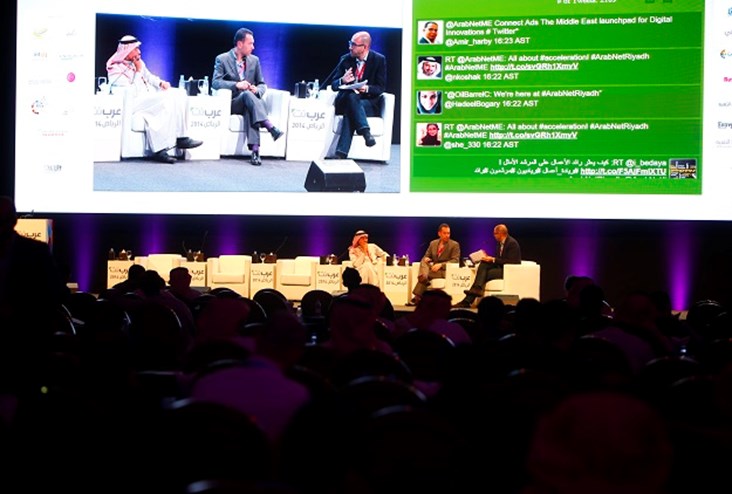How Digital Platforms Transformed Marketing for FMCGs
Back
In 2013, Fast Moving Consumer Goods. or FMCG for short, overtook financial services as the number one spender on digital display advertising in the UK. Over in Saudi Arabia, digital spend by the Food & Snacks category doubled from 2012 to 2013 according to Digital Media Services DMS. FMCGs have proven to be some of the most advanced online advertisers, adopting new platforms like online video and branded content before most other sectors. Here to shed light on how digital platforms are transforming marketing for FMCGs and how these household names are managing their massive following on social media are Khaled Tash, Chief Marketing Officer at AMS Baeshen, and Will Platt-Higgins Director of Global Account Partnerships at Facebook.
This discussion took place at ArabNet Riyadh and was moderated by Ziad Khammar, Strategy and Development Director at DMS.
On the global marketing scale, digital occupies 25% of all media spent in the region. Digital media services at Choueiri Group see 6 to 8% added Khammar, but neither these numbers seemed to satisfy Tash. At AMS Baeshen, 80% of the communication budget was spent on social, digital and online in 2014, which in turn represents a quarter of the total marketing spend. This is “a reasonable mix” according to Tash, who goes on to state that “if you’re any less than half your budget on digital or social, you are doing something wrong.”
Tash however was clear in attributing this bold approach to the fact that they were a local and smaller company, which usually holds advantage of being more flexible and faster to execute change. He does acknowledge that it would be more difficult for bigger companies, i.e. “for someone that had invested so much time and energy, usually from an older generation.”
“But two thing are key,” he goes on to say, “you have to prove it.” Use data to support your case; show that the media landscape has changed. “Any failure to convince boards, CEOs, or top decision makers on the need to transition the majority of your budget, or a big portion of your budget, into social and digital is a failure of the marketeer himself.”
Some things never change
The other key part is the measurement. If you try to measure the effect of digital - market share and ROI - differently than you did before, “you are going to fail. The fundamentals remain the same.” You need to prove that social media, digital and online will give you the same results in terms of market share, sales, awareness, etc.
Platt-Higgins joins the conversation and states that we are in a middle of a transition period, and draws a comparison to mid 50s after the television was introduced and was overtooking radio, “and it’s kinda scary to be a marketer and agency out there and figure out what to do.”
He cites a famous quote, about 15 years old, from the global director of Nike: “It’s not that i have a bias towards digital, it’s that i have a bias towards my consumer.” This goes on to show that marketers ought to be guided by the mantra that the consumer is boss, “and we need to look where people are spending their time.” You walk outside now to have a glass of water he says, and you’ll see that everyone is glued to their phones. He also echoed Tash’s view on the difficulty of convincing companies to shift their budget to digital.
Content is the biggest challenge
Going back to Tash: “I really get frustrated when a brand tells me ‘good morning’ on Facebook, that’s not your job as a brand.” One of the things that has worked well at AMS Baeshen was finding and focusing on just two relevant topics and delivery entertaining and informative content. It was “more relevant, more useful, more engaging.”
Platt-Higgins again echoed Tash’s point. “Relevance is key. You don’t need to feel that you need to be pushing stuff out every single day (...) it’s better to think what is the best most relevant content, and push that out and make sure that it is seen at scale.” The latter isn’t easy, as he points out that up to 80% of the post is seen by less than five thousand people.
There is a high anti advertising sentiment
“The perception of advertising, of a direct branded communication message that comes to you as a consumer, is really really in trouble,” according to Tash. So the challenge of content isn’t just about the message, but about delivery as well.
Stop buying fans
“We do not recommend people continue to spend their investment acquiring fans, we recommend that people spend their investment reaching the people that matter to them.” And that’s where content comes into play concludes Khammar.
Moving on to the last theme of the panel: mobile
Starting with the basics, make sure that any piece of content that you develop is mobile friendly, “be it video, a key visual, an image,” etc. Another trick according to Tash, since mobile is dominated by apps: “experimented with purely branded apps that you come up with,” but also “experiment with tying up funding, sponsoring, advertising, product placement within apps that you believe have relevance to your target audience.”
There is a lot more where this came from. Make sure you watch the full panel pasted below.
Latest Business
Intelligence Report














